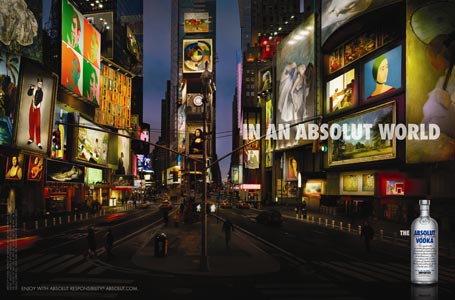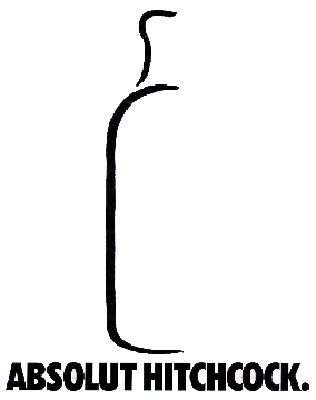Why the Absolut Campaign Switch Worked

Last year, Absolut abandoned its classic “bottle” ad campaign. That long-running series of ads featured the shape of an Absolut bottle cleverly concealed in an illustration, and was largely responsible for establishing Absolut vodka as one of the most popular and well-recognized brands in the spirits field. I was surprised by the change, but even wildly successful ad programs eventually have to break with the past. The good news for the makers of Absolut is that their new campaign, “An Absolut World,” has bumped their sales by almost ten percent according to a new story in Breaking With Bottle Fires Up Absolut Sales. I think that the neuromarketing similarities of the two campaigns explain why there was no loss of momentum.
 I’ve written about Absolut’s bottle ads in the past. In Art, Science, and Ads, I noted,
I’ve written about Absolut’s bottle ads in the past. In Art, Science, and Ads, I noted,
..the long-running and wildly successful ad campaign employed by Absolut Vodka [serves] as an example of ads that appealed to our brain’s desire to acquire information. That same campaign ties neatly into several of Ramachandran’s key principles for effective art. The illustrations, in many cases, are mere outlines of the product’s distinctive bottle (isolation), and often require the viewer to study the ad for a second to see the pattern emerge (perceptual problem solving). The ads often are visual puns of some sort, as well. Before the term “neuromarketing” had been coined, the Absolut ad designers had developed a long-running campaign well-targeted to the way the human brain processes information. Whether or not the viewer was a vodka drinker, the nature of the ads made them very difficult to flip past without at least a quick look.
In my earlier post, Marketing to the Infovore, I described how the brain’s reward system favors new information, one form of which is solving a problem:
These highly creative images [in the Absolut ads] were not only novel, they often contained a bit of humor or playfully incorporated some concept that would take a bit of thought for the viewer to fully connect. From an infovore perspective, one would have to say these images were just about perfect – not only were they novel and unexpected, they frequently produced a little “aha, I get it!” reward to the viewer.
Absolut World Campaign
The new Absolut World campaign was in one respect a sharp break from the old bottle series. It incorporates impossible images that invite the viewer to imagine a more perfect world: an obviously pregnant man, a politician giving a speech who is growing a Pinocchio-like nose, and Times Square filled not with garish neon and video screens but rather gently illuminated artwork. The viewer is invited to think of an Absolut world as a sort of perfection that won’t happen. The unspoken message is, “You’ll never see Times Square like this, but you CAN appreciate the perfection of Absolut.”
Comparing the two campaigns, though, the common neuromarketing characteristics are quite remarkable. Both series offer startling and novel visual images that are definitely hard to pass by in a magazine or on a billboard. Both series require the viewer to decode the image in some way and will result in a similar, “Aha! I get it!” reaction. Neither campaign is overly puzzling or problematic, but both contain information that that requires a bit of cognitive processing. That differs from a spirits ad that might just show the product being enjoyed by attractive people in an upscale environment; in that case, most of the cues (attractive man, sexy woman, expensive restaurant background, waiter in a tuxedo, etc.) are meant to be processed unconsciously.
The difference between the two Absolut campaigns is simple and logical. The bottle ads served to establish the Absolut bottle as an instantly recognizable icon. The premium quality of the product could be established only indirectly by using high quality, creative artwork and occasionally through the subject of the artwork – a custom swimming pool in the shape of the bottle, for example.
As long as the bottle campaign ran, it may have reached a point of serious diminishing returns – the brand was established, the bottle shape was iconic, but there wasn’t an easy way within that campaign to further enhance the brand image. This was confirmed in the Ad Age article by Ian Crystal, Absolut’s brand director, who said, “A lot of our key numbers had been flat or declining.”
The Absolut World campaign didn’t need to establish the brand or packaging, so it could focus on the message that Absolut vodka is the closest thing to perfection one can find in this world.
I remain a bit sad that new Absolut bottle ads aren’t being created, but I commend Absolut and TBWA/Chiat/Day for simultaneously breaking with tradition while still maintaining some of the key elements that made the past campaign so successful.

Transitioning from one world class ad campaign to another is one of the hardest things to do right. I think that the neuromarketing triggers of the first Absolut campaign, enabled the slightly deeper triggers for the second campaign.
People are used to a bit of puzzling with Absolut advertising, which leads them to try to get the “Aha! I get it moment” of the new campaign.
I would also bet this decoding behavior of a subtle message is probably linked to Absolut’s intended consumer target as well.
As always, a very intriguing post.
I think that it is too soon to have elaborate opinions about the possible effects of the new Absolut advertising campaign. After running for merely a year it still has a lot to prove in comparison with the previous long running campaign.
When companies introduce a new campaign they often increase the media budget as well. Therefore it becomes hard to say whether the sales increase is a result of the increased media budget or a consequence of the new ad campaign. I don’t know to what extent Absolut or rather Vin & Sprit (The Swedish Corporation which owns the brand Absolut)have increased their media budget or not. In the article in AdAge that was referred to in the post above they are explicitly stating that there are no available figures of media spending.
Consequently, the current sales of Absolut says Absolutely nothing about the new advertising campaign! 🙂
Good points, Utbilding. There are a lot of variables that go into even minor changes in sales. Perhaps we can at least say that the new campaign didn’t destroy the brand and cause sales to tank!
Roger